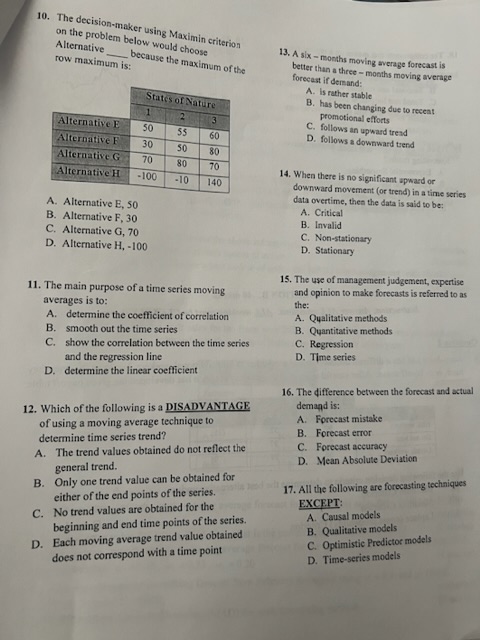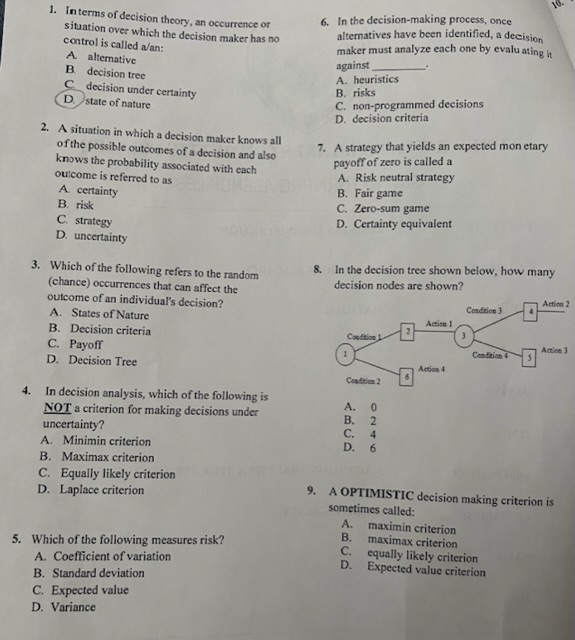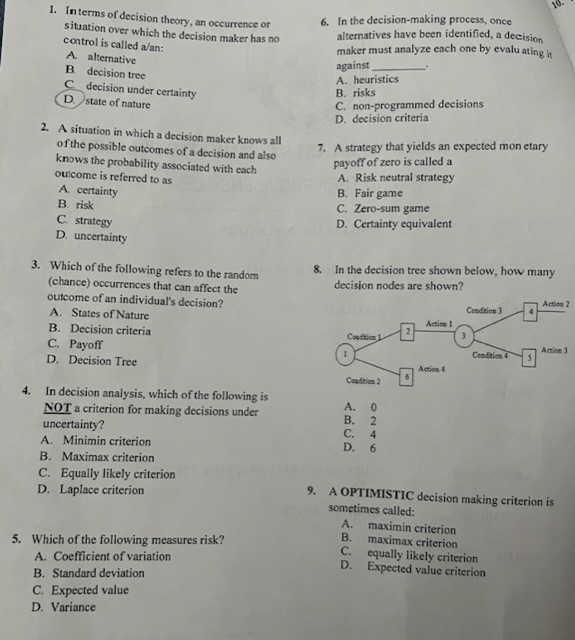Answered step by step
Verified Expert Solution
Question
1 Approved Answer
10. The decision-maker using Maximin criterion on the problem below would choose Alternative row maximum is: because the maximum of the 13. A six -


 10. The decision-maker using Maximin criterion on the problem below would choose Alternative row maximum is: because the maximum of the 13. A six - months moving sverage forecast is better than a three - months moving average forecest if dereand: A. is rather stable B. has been changing due to receat promotional efforts C. follows an upward tread D. follows a downward tend 14. When there is no significant apward or A. Alternative E, 50 downward movement (or trend) in a time series data overtime, thes the data is said to be: B. Alternative F,30 A. Critical C. Alternative G,70 B. Invalid D. Alternative H,100 C. Non-stationary D. Stationary 11. The main purpose of a time series moving 15. The use of management judgement, expertise averages is to: and opinion to make forecasts is referred to as the: A. determine the coefficient of correlation A. Qualitative methods B. smooth out the time series B. Quantitative methods C. show the correlation between the time series C. Regression and the regression line D. Time series D. determine the linear coefficient 16. The difference between the forecast and actual 12. Which of the following is a DISADVANTAGE demagd is: of using a moving average technique to A. Forecast mistake determine time series trend? B. Forecast error A. The trend values obtained do not refleet the C. Forecast accuracy general trend. D. Mean Absolute Deviation B. Only one trend value can be obtained for either of the end points of the series. 17. All the following are forecasting techniques C. No trend values are obtained for the EXCFPT: beginning and end time points of the series. A. Causal models D. Each moving average trend value obtained B. Qualitative models does not correspond with a time point C. Optimistic Predictor models D. Time-series models 1. In terms of decision theory, an occurrence or situation over which the decision maker has no 6. In the decision-making process, once control is called a/an: alternatives have been identified, a decision A. alternative maker must analyze each one by evalu ating it B. decision tree against C decision under certainty A. heuristics D. state of nature B. risks C. non-programmed decisions 2. A situation in which a decision maker knows all D. decision criteria of the possible outcomes of a decision and also 7. A strategy that yields an expected mon etary knows the probability associated with each payoff of zero is called a outcome is referred to as A. Risk neutral strategy A. certainty B. Fair game B. risk C. Zero-sum game C. strategy D. Certainty equivalent D. uncertainty 3. Which of the following refers to the random (chance) occurrences that can affect the 8. In the decision tree shown below, how many decision nodes are shown? outcome of an individual's decision? A. States of Nature B. Decision criteria C. Payoff D. Decision Tree 4. In decision analysis, which of the following is NOT a criterion for making decisions under uncertainty? A. Minimin criterion B. Maximax criterion C. Equally likely criterion D. Laplace criterion 1. In terms of decision theory, an occurrence or situation over which the decision maker has no 6. In the decision-making process, once control is called a/an: alternatives have been identified, a decision A. alternative maker must analyze each one by evalu ating it B. decision tree against C decision under certainty A. heuristics D. state of nature B. risks C. non-programmed decisions 2. A situation in which a decision maker knows all D. decision criteria of the possible outcomes of a decision and also 7. A strategy that yields an expected mon etary knows the probability associated with each payoff of zero is called a outcome is referred to as A. Risk neutral strategy A. certainty B. Fair game B. risk C. Zero-sum game C. strategy D. Certainty equivalent D. uncertainty 3. Which of the following refers to the random (chance) occurrences that can affect the 8. In the decision tree shown below, how many decision nodes are shown? outcome of an individual's decision? A. States of Nature B. Decision criteria C. Payoff D. Decision Tree 4. In decision analysis, which of the following is NOT a criterion for making decisions under uncertainty? A. Minimin criterion B. Maximax criterion C. Equally likely criterion D. Laplace criterion
10. The decision-maker using Maximin criterion on the problem below would choose Alternative row maximum is: because the maximum of the 13. A six - months moving sverage forecast is better than a three - months moving average forecest if dereand: A. is rather stable B. has been changing due to receat promotional efforts C. follows an upward tread D. follows a downward tend 14. When there is no significant apward or A. Alternative E, 50 downward movement (or trend) in a time series data overtime, thes the data is said to be: B. Alternative F,30 A. Critical C. Alternative G,70 B. Invalid D. Alternative H,100 C. Non-stationary D. Stationary 11. The main purpose of a time series moving 15. The use of management judgement, expertise averages is to: and opinion to make forecasts is referred to as the: A. determine the coefficient of correlation A. Qualitative methods B. smooth out the time series B. Quantitative methods C. show the correlation between the time series C. Regression and the regression line D. Time series D. determine the linear coefficient 16. The difference between the forecast and actual 12. Which of the following is a DISADVANTAGE demagd is: of using a moving average technique to A. Forecast mistake determine time series trend? B. Forecast error A. The trend values obtained do not refleet the C. Forecast accuracy general trend. D. Mean Absolute Deviation B. Only one trend value can be obtained for either of the end points of the series. 17. All the following are forecasting techniques C. No trend values are obtained for the EXCFPT: beginning and end time points of the series. A. Causal models D. Each moving average trend value obtained B. Qualitative models does not correspond with a time point C. Optimistic Predictor models D. Time-series models 1. In terms of decision theory, an occurrence or situation over which the decision maker has no 6. In the decision-making process, once control is called a/an: alternatives have been identified, a decision A. alternative maker must analyze each one by evalu ating it B. decision tree against C decision under certainty A. heuristics D. state of nature B. risks C. non-programmed decisions 2. A situation in which a decision maker knows all D. decision criteria of the possible outcomes of a decision and also 7. A strategy that yields an expected mon etary knows the probability associated with each payoff of zero is called a outcome is referred to as A. Risk neutral strategy A. certainty B. Fair game B. risk C. Zero-sum game C. strategy D. Certainty equivalent D. uncertainty 3. Which of the following refers to the random (chance) occurrences that can affect the 8. In the decision tree shown below, how many decision nodes are shown? outcome of an individual's decision? A. States of Nature B. Decision criteria C. Payoff D. Decision Tree 4. In decision analysis, which of the following is NOT a criterion for making decisions under uncertainty? A. Minimin criterion B. Maximax criterion C. Equally likely criterion D. Laplace criterion 1. In terms of decision theory, an occurrence or situation over which the decision maker has no 6. In the decision-making process, once control is called a/an: alternatives have been identified, a decision A. alternative maker must analyze each one by evalu ating it B. decision tree against C decision under certainty A. heuristics D. state of nature B. risks C. non-programmed decisions 2. A situation in which a decision maker knows all D. decision criteria of the possible outcomes of a decision and also 7. A strategy that yields an expected mon etary knows the probability associated with each payoff of zero is called a outcome is referred to as A. Risk neutral strategy A. certainty B. Fair game B. risk C. Zero-sum game C. strategy D. Certainty equivalent D. uncertainty 3. Which of the following refers to the random (chance) occurrences that can affect the 8. In the decision tree shown below, how many decision nodes are shown? outcome of an individual's decision? A. States of Nature B. Decision criteria C. Payoff D. Decision Tree 4. In decision analysis, which of the following is NOT a criterion for making decisions under uncertainty? A. Minimin criterion B. Maximax criterion C. Equally likely criterion D. Laplace criterion Step by Step Solution
There are 3 Steps involved in it
Step: 1

Get Instant Access to Expert-Tailored Solutions
See step-by-step solutions with expert insights and AI powered tools for academic success
Step: 2

Step: 3

Ace Your Homework with AI
Get the answers you need in no time with our AI-driven, step-by-step assistance
Get Started


